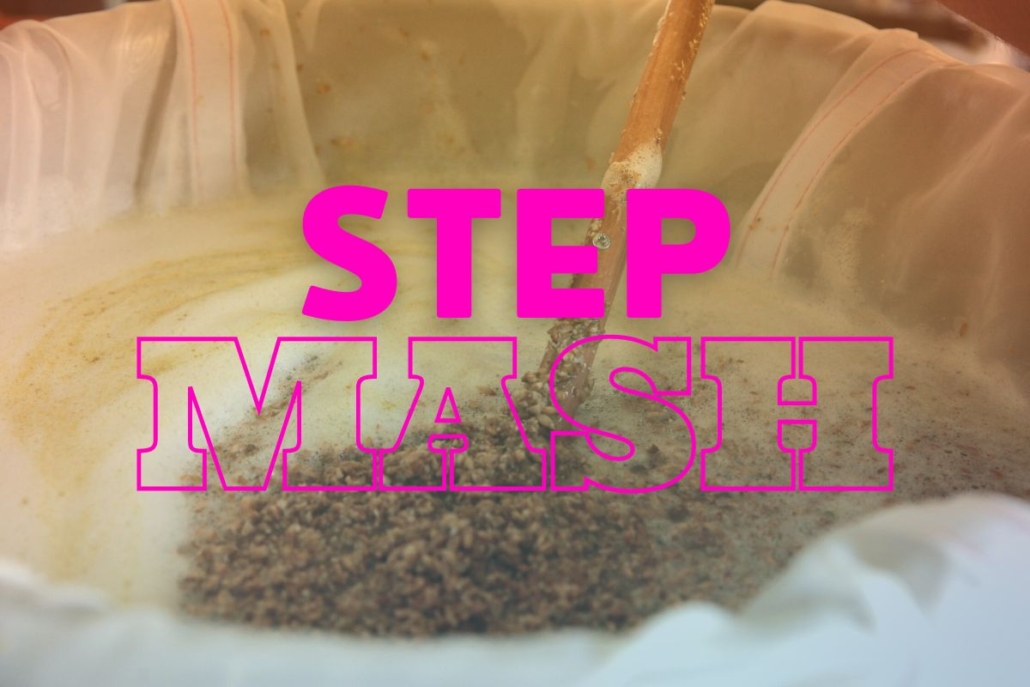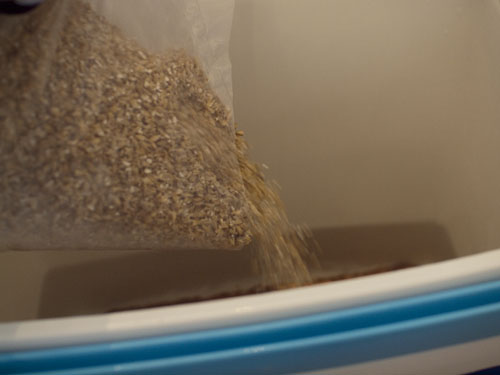Step Mash – A Guide To Multi-Rest Mashing

Step mashing or multi-rest mashing is a method of all-grain brewing where the mash is taken up through multiple steps from lower temperatures to higher temperatures.
What is the purpose of step mashing and when is it suitable to perform a step mash? In this article, we will cover these points and learn how to use this technique to refine our homebrew beers.
Table of Contents
What Is Step Mashing?

Step mashing or multi-rest mashing is the process of combining the malt we are using for a recipe with water at varying temperature steps.
Unlike a basic infusion mash where we combine grain and water at a set temperature of around 64-66°C and leave the mash. A step mash would involve separate steps starting for instance at 50°C then rising to 65°C and then onto 75°C.
The method of raising the temperature of the mash is through either direct heat if your mash tun can be heated or through additions of boiling water of set quantities that raise the mash to the required temperature.
Why Would You Need To Step Mash?
Step mashes sound like a lot of work compared to a single infusion mash so why would you bother?
The truth is that step mashes almost always have a better yield and efficiency than single infusion mashes. They also give the brewer the ability to control which enzymes are activated throughout the mash and this has the consequence of altering the body and mouthfeel of the finished beer.
Enzymes are present within the malt and grains used to mash. These enzymes are responsible for breaking down various parts of the malt, for example, amylase enzymes break down starch into fermentable sugars.
As you progress through a step mash enzymes are activated according to the temperature and thickness of the mash. Protein-degrading enzymes are activated at lower mash temperatures, the next step activates starch-degrading enzymes and each step leads to an optimal period for each enzyme.
What Enzymes Are In The Mash?
Enzymes are types of proteins that facilitate chemical reactions. An easy-to-understand example is the enzymes present in fruit that lead to them ripening and eventually overripening.
Malting barley utilised the enzymes in the grain to get it ready to grow a sprout before turning it into a plant.
The enzymes are still present when the brewer comes to mash them and depending on the temperature of the mash we can decide what enzyme to target.
The most common enzymes we can target in a step mash are the following:
Beta Glucanase
Temperature range: 35 – 45°C (95 – 113°F)
Glucans are the gummy components of the grain. A rest at this temperature is good to break down gums in unmalted adjuncts.
Protease / Peptidase
Target range: 46 – 55°C (115 – 131°F)
These two enzymes target protein molecules. A protein rest aids head retention and breaks down protein in malts that are less modified such as pilsner malt. Typically leads to better yields in high adjunct mashes.
Beta-Amylase
Target range: 60 – 65°C (140 – 149°F)
Targets starch and converts to maltose which is the favored sugar for the yeast to ferment. This leads to a more fermentable wort and less residual sweetness in the finished beer.
Alpha-Amylase
Targets starches and breaks them down into a variety of sugars and dextrins. Typically leads to a slightly less fermentable wort and a residual sweetness in the beer or more full-bodied.
Target range: 65 – 71°C (149 – 160°F)
There are other enzymes in the mash but when performing a step mash those listed above are the most commonly targeted by a rest at each step.
Typical Step Mash Schedules

Below are some typical examples of step mash schedules that a brewer may use to make a certain style of beer or to alter the body and fermentability of the finished beer.
Light-Bodied Beer
First Step: Protein rest at temperature 50C for 30 minutes
Second Step: Saccharification rest at 64C for 30 – 40 minutes
Third Step: Mash out, increase temperature to 75C for 5 – 10 minutes to decrease viscosity before sparge.
Medium Bodied Beer
First Step: Protein rest at a temperature of 50°C for 30 minutes
Second Step: Saccharification rest at 64°C for 10 minutes
Third Step: Increase temperature to 68°C for 30 minutes
Fourth Step: Mash out, and increase the temperature to 75°C for 5 – 10 minutes to decrease viscosity before sparging.
Full-Bodied Beer
First Step: Protein rest at temperature 50°C for 30 minutes
Second Step: Saccharification rest at 69°C for 30 – 40 minutes
Third Step: Mash out, and increase the temperature to 75°C for 5 – 10 minutes to decrease viscosity before sparging.
High Adjunct Mash
First Rest: Mash in at 40C which will target both protein and beta-glucanase to break down gums. Rest for 30 minutes.
Second Rest: Increase temperature to 50°C and rest for 30 minutes
Third Rest: Saccharification rest at 65°C for 45 minutes
Forth Rest: Mash out by increasing temperature to 75°C which will decrease viscosity and then begin sparge.
Increasing The Mash Temperature In Steps
A multi-rest mash requires that the temperature of the mash is heated at each specific step. If you can directly heat the mash tun then this isn’t a problem. You simply apply heat and stir the mash to avoid creating hot spots.
If you cannot directly heat your mash tun you will need to add infusions of hot water to increase the temperature through each step of the mash.
Calculating Hot Water Addisiotn For A Multi-Rest Mash
After your initial infusion which in a step mash is likely to be the temperature of your protein rest you will need to add additions of hot water to increase the temperature
The equations below will allow you to calculate your additions.
Initial Infusion:
If you are using Fahrenheit, Pounds and Quarts then you’ll need to change the constant of 0.41 to 0.2
Strike Water Temperature Tw = (0.41 / R)(T2 – T1) + T2
- Wa = The amount of infusion water to add
- Wm = The total amount of water in the mash
- T1 = The initial mash temperature (temperature of dry grain for initial infusion)
- T2 = The target mash temperature
- Tw = the actual temperature of the infusion water
- G = The amount of grain in the mash
- R = The ratio of grain to water in the mash
Mash Infusion To Increase Temperature For Each Step
Wa = (T2-T1)(0.41G + Wm) / (Tw – T2)
While this may seem confusing there is plenty of free software online and brewing calculators that will perform these calculations automatically. These equations really just show you how to go about increasing the temperature of the mash.
Is It Necessary To Perform Multi-Step Mashes
In practice, multi-step mashes are more work and they take a long time so is it worth doing these as a home brewer?
In most cases, a single infusion mash is all that is required. Modern malts are typically well-modified. A step mash will likely have high yields and efficiency but on such a small scale it is not going to equate to very much.
The main reason why you would consider using a step mash then would be the following:
- Recipes with large amounts of unmalted adjuncts
- Recipes such as continental lagers use moderately modified malts. A multi-rest mash will result in better yields than single infusion mashes.
The only way to tell if a step mash is worth the extra effort is to give it a try yourself. The added technique to your brewing process you might actually enjoy the practice and it is fun to experiment with.




Leave a Reply
Want to join the discussion?Feel free to contribute!